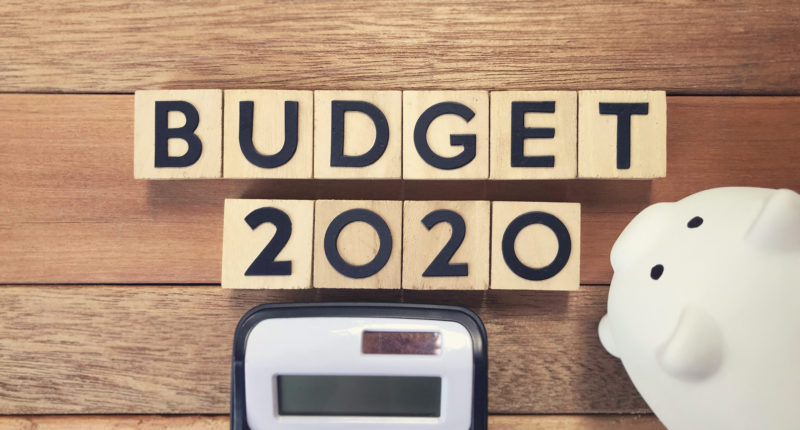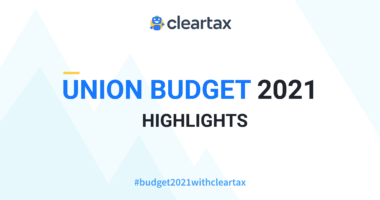The Budget of the Central Government is not merely a statement of receipts and expenditure. Since Independence, it has become a significant statement of government policy. The Budget reflects and shapes, and is, in turn, shaped by the country’s economy.
Let’s recap on Budget 2020 to get a fair idea about the government’s significant steps in various sectors of the Indian economy.
Fiscal Management:
| For Financial Year 2018-19 (Actuals): | For Financial Year 2019-20 (Revised Estimates): | For Financial Year 2020-21 (Estimates) |
| Receipts:
Rs.16.66 lakh crore Expenditure: Rs.23.15 lakh crore |
Receipts:
Rs.19.32 lakh crore Expenditure: Rs.26.99 lakh crore |
Receipts:
Rs.22.46 lakh crore Expenditure: Rs.30.42 lakh crore GDP growth rate: 10% |
Budget Allocation
- Various Ministries
| Ministries and Departments | Budget allocated
(Rs. in Crore) |
| Ministry of Defence | 471378 |
| Ministry of Home Affairs | 167250 |
| Ministry of Agriculture and Farmers’ Affairs | 142762 |
| Ministry of Consumer Affairs, Food and Public Distribution | 124535 |
| Ministry of Rural Development | 122398 |
| Ministry of Human Resource and Development | 99312 |
| Ministry of Road Transport and Highways | 91823 |
| Ministry of Railways | 72216 |
| Ministry of Health and Family Welfare | 67112 |
| Ministry of Housing and Urban Affairs | 50040 |
- Major Schemes
| Scheme Name | Budgeted 2020-21
(Rs. in Crore) |
Revised Estimates 2019-20 (Rs. in Crore) |
| PM Kisan | 75000 | 54370 |
| Pradhan Mantri Swastha Suraksha Yojana | 6020 | 4733 |
| DBT- PAHAL for LPG | 35605 | 29628 |
| Integrated Child Development Services(ICDS) | 28557 | 24955 |
| Pradhan Mantri Awas Yojana | 27500 | 25328 |
| Pradhan Mantri Gram Sadak Yojana | 19500 | 14070 |
Budget 2020 theme “Ease of Living” is supported by clean, corruption-free, policy-driven, good in intent and trusting in faith governance and sound reforms made in the financial sector.
|
Ease of Living |
||
| Aspirational India
Agriculture, Irrigation and Rural development Wellness, Water and Sanitation Education and Skills |
Economic Development
Industry, Commerce and Investment Infrastructure New Economy |
Caring Society
Women, Child and Social Welfare Culture and Tourism Environment and Climate Change |
A. Agriculture, Irrigation and Rural Development: Agriculture sector constitutes 16% of India’s GDP. Budget 2020 allocated Rs.1.6 lakh crore for agriculture, irrigation and allied activities and Rs.1.23 lakh crore for the rural sector covering below 16 points:
- Encourage state governments, who implement model laws issued by the Central Government.
- Comprehensive measures to be taken for 100 water-stressed districts.
- PM KUSUM scheme to help 20 lakh farmers set up standalone solar pumps, 15 lakh farmers to solarise their grid-connected pump sets and farmers with barren land to set up solar units for power generation and sell excess power to the solar grid.
- Warehouses to be created in line with WDRA norms and Viability Gap.
- Funding for setting up efficient warehouses on PPP mode.
- SHGs to run Village Storage Scheme which would provide the adequate holding capacity to village farmers.
- Through the PPP arrangement, Kisan Rail was set up by the Indian Railways to build a seamless national cold supply chain for perishable goods.
- To improve agricultural products’ realisation primarily for the northeast and tribal districts by transportation, the Ministry of Civil Aviation launched the Krishi Udan scheme on the International and National routes.
- The supporting states to focus on One Product for One District, a cluster approach, to increase momentum in the horticulture sector.
- The government will take measures for expansion of Organic, Natural and Integrated farming.
- MNREGS to be dovetailed to develop fodder farms and facilitate the doubling of the processing capacity of milk from 53 million MT to 108 million MT by 2025.
- Increase in Artificial insemination to 70% from the present 30%.
- Agricultural credit target set to Rs.15 lakh crore for 2020-21.
- Elimination of FMD, brucellosis in cattle and PPR in sheep by 2025.
- It proposed to integrate Negotiable Warehousing Receipts (e-NWR) e-NAM.
- Growing of algae, sea-weed and cage culture to be promoted.
- Two hundred lakh tonnes of fish production targeted by 2022-23. Promoting Fishery exports to Rs.1 lakh crore by 2024-25. Fishery extension through 500 fish FPO’s and 3,477 Sagar Mitras. Aqua-culture to be supported by another 45,000 acres.
B. Wellness, Water and Sanitation: It is proposed to allocate Rs.69,000 crore to the healthcare sector.
- PM Jan Arogya Yojana(PMJAY): Rs.6,400 crore was allocated to this scheme so that more hospitals can be empanelled under PMJAY scheme from Tier-II and Tier-III cities.
- Viability Gap Funding is proposed to set up hospitals in the PPP mode, first covering 112 aspirational districts with no empanelled hospitals.
- Targeting diseases with an appropriately designed preventive regime by machine learning and artificial intelligence.
- TB Harega Desh Jeetega campaign to be strengthened to eliminate TB disease by 2025.
- Jan Aushadhi Kendra Scheme aims to provide 2,000 medicines and 300 surgical in all the districts by 2024.
- Allocation of Rs.3.6 lakh crore to Jal Jeevan Mission out of which Rs.11,500 crore is for the year 2020-21.
- Rs.12,300 crore allocated to Swachh Bharat Mission for focus on Liquid and greywater management.
- ODF plus to sustain the ODF programme and emphasis to take up solid and liquid waste management.
C. Education and Skills: Rs.99,300 crore to be allocated for the education sector and about Rs.3,000 crore for skill development.
- As per the Finance Minister, about 150 higher educational institutions will start apprenticeship embedded courses.
- Urban local bodies to create internship opportunities for fresh engineers for one year.
- Proposal to introduce degree level, full-fledged online education programme by ranked institutions for the students of deprived sections of the society.
- External Commercial Borrowings (ECB) and FDI sourcing can create Infrastructure in the education sector to deliver high-quality education.
- Study in India programme, Ind- SAT, to be conducted in Asia and Africa.
D. Industry, Commerce and Investment: The Finance Minister allocated Rs.27,300 crore for the promotion of the commerce and industry sector for the financial year 2020-21
- It is proposed to increase the focus on manufacturing electronic equipment to increase job opportunities in this sector.
- National Technical Textile Mission to be implemented from 2020-21 to 2023-24 with Rs.1,480 crore estimated cost.
- NIRVIK scheme to be launched for higher export credit disbursement. It also aims to provide higher insurance coverage, reduce the premium for small exporters, and simplify claim settlement.
- All ministries to issue Quality Standard Orders to remove defects in manufacturing as per PM’s view of “Zero Defect Zero Effect Manufacturing.”
- Investment Clearance Cell to be set up that will provide end to end facilitation.
- Scheme to be introduced to provide subordinate debt for entrepreneurs of MSMEs. Also, enable NBFCs to extend invoice financing to the MSMEs through TReDs.
E. Infrastructure: As per budget 2020 Rs.100 lakh crore to be invested on Infrastructure for the next five years.
- National logistics policy shall be introduced to create a single-window e-logistics market.
- National Infrastructure Pipeline projects for Rs.103 lakh crore are announced.
- It is proposed to allocate Rs.1.7 lakh crore for transport infrastructure.
- Highways: Proposed accelerated development of highways. Minimum 12 lots of highway bundles of 6,000 km to be monetised by 2024.
- Railways: Redevelopment projects for four stations and operation of 150 passenger trains through PPP mode. More Tejas types train for tourist destinations.
- Port: At least one seaport to be corporatised by the end of the year and list it under stock exchange.
- Air: 100 more airports to be developed by 2024 under the UDAAN scheme.
- Power: Conventional energy meters to be replaced by prepaid smart meters by the next three years.
- Gas Grid: Proposed to expand the National Gas Grid by 27,000 km.
F. New Economic: An outlay of Rs.8,000 crore proposed on National Mission on Quantum Technologies and applications over five years.
- It is proposed to Set up Knowledge Translation Clusters for emerging technology sectors and scaling up Technology Clusters, harbouring testbeds and small scale manufacturing facilities.
G. Women, Child and Social Welfare: Rs.35,600 crore allocated for Nutritional related programmes and Rs.28,600 crore for women-specific programmes.
- For the concerns related to Senior citizens and Divyang, enhanced allocation of Rs.95,00 crore is proposed.
- A task force to be appointed to recommend regarding lowering of MMR and improving nutrition levels
- Rs.85,000 crore allocated for the welfare of Scheduled castes and Other backward classes and Rs.53,700 crore proposed for further development and welfare of Scheduled Tribes.
H. Culture and Tourism: Rs.2,500 crore allocated for the promotion of tourism.
- An Indian Institute of Heritage and conservation is proposed to be established.
- Five archaeological sites to be developed as iconic sites.
- A numismatics and trade museum to be located in the historic Old Mint building of Kolkata and setting up Tribal museum in Ranchi and Maritime museum in Lothal.
I. Environment and Climate change: Rs.4,400 crore allocated for the environment and climate change.
- It is proposed to encourage states to implement plans for cleaner air in the cities above 1 million population.
J. Governance
- An independent, professional and specialist organisation “National Recruitment Agency” will conduct online common eligibility tests for recruitment to Non-Gazetted posts.
- Governance is guided by “Sabka Saath, Sabka Vikas, Sabka Vishwas” focusing on affordable housing, digital penetration, clean energy and preventive healthcare.
K. Financial Sector
- DICGC to increase deposit insurance coverage from Rs.1 lakh to Rs.5 lakh for each depositor.
- Eligibility limit of NBFCs for debt recovery under the SARFAESI Act 2002 is proposed to be reduced to Rs.100 crore of asset size from Rs.500 crore or loan size from Rs.1 crore to Rs.50 lakh.
- The government proposes to sell the balance holding of the government in IDBI through the stock exchange.
- FPI limit of corporate bonds to be increased to 15%.
- New debt-based ETF proposed mainly for government securities.
L. Tax Proposals
- Residential status: Criteria to determine the residential status of a person is changed. If a person resides in India for more than 120 days, he is deemed a resident of India. If any Indian citizen is not liable to pay tax in any other country or territory, he is deemed a resident of India.
- For individuals and HUF: Introduction of new tax regime for individual and HUF with the change in tax slab rates and the removal of 70 exemptions and deductions of different natures. Once a new tax regime is opted by the person, it will apply to all subsequent years.
| Taxable Income Slab (Rs.) | Old Tax Rates | New Tax Rates |
| 0 – 2.5 lakh | Exempt | Exempt |
| 2.5 lakh – 5 lakh | 5% | 5% |
| 5 lakh – 7.5 lakh | 20% | 10% |
| 7.5 lakh – 10 lakh | 20% | 15% |
| 10 lakh – 12.5 lakh | 30% | 20% |
| 12.5 lakh -15 lakh | 30% | 25% |
| Above 15 lakh | 30% | 30% |
- Domestic companies: Concessional corporate tax rate at 15% is proposed to new domestic companies in the manufacturing and power sectors.
- Option to other domestic companies and cooperative societies to pay income tax at 22% without claiming certain deductions as provided in the Act.
- Dividend distribution tax: It is proposed that the dividend distribution tax of 15% will now be payable by the recipient of the dividend instead of levying tax on companies paying the dividend.
- Taxation of startups: The turnover limit is increased to Rs.100 crore for 100% deduction of the profits of the startups. The eligibility period for claiming the deduction is changed to ‘any 3 years out of the first 10 years’.
- Employer’s contribution: The combined upper limit to claim a deduction for the contribution to recognised provident fund, National Pension Scheme and superannuation fund is fixed to Rs.7.5 lakh. Any amount contributed more than the above limit is treated as perquisite in the hands of the employee. Any interest or dividend or any other income accrued from the fund/scheme during the year related to the employer’s contribution will be treated as perquisite.
- 1% TDS for e-commerce transactions: TDS under section 194O to be deducted by e-commerce operators for transactions made with e-commerce participants.
- ESOPs: Tax deduction on notional gains at the time of allotment of ESOPs to employees is deferred. It is now proposed to be paid within 14 days of the earliest of the following:
- On the expiry of five financial years from the end of the year, the shares under ESOP have been allotted.
- Date of employees leaving employment.
- Date of sale of such shares.
- PAN can now be applied online through Aadhaar without submitting any additional documents.
- While computing capital gains in sellers’ hands, It is proposed to increase the limit of variance from 105% to 110%, where stamp duty value is considered the sale consideration.
- To avail an additional deduction of Rs.1.5 lakh relating to house property valued up to Rs.45 lakh, it is proposed to extend the time limit until 31st March 2021 for getting housing loans sanctioned.
- Proposal to extend faceless mode to assessment for the first level of appellate and penalty proceedings.
- “Vivaad se Vishwaas” scheme to be introduced for Direct tax dispute settlement.
- An amendment in Companies Act is proposed to bring provisions of criminal liability in certain areas.
- Indirect tax: Custom duty is raised on footwear and furniture goods to 35% and 25% respectively. Also, duty on goods like auto-parts, chemicals, etc. to be raised.
- Custom duty rates on electric vehicles and parts to be revised.
- Health cess: In addition to customs duty, 5% health cess to be levied on import of medical devices, except those exempted from BCD.
- Excise duty is proposed to be raised on cigarettes and other tobacco products.
- Charity institutions: Issuance of Unique Registration Number for easy tax compliance.
- GST: GST returns in a simplified form to be implemented from 1st April 2020. Also, GST refund process to be fully automated.
For any clarifications/feedback on the topic, please contact the writer at namita.shah@cleartax.in

I’m a chartered accountant and a functional CA writer by profession. Reading and travelling in free time enhances my creativity in work. I enjoy exploring my creative side, and so I keep myself engaged in learning new skills.





